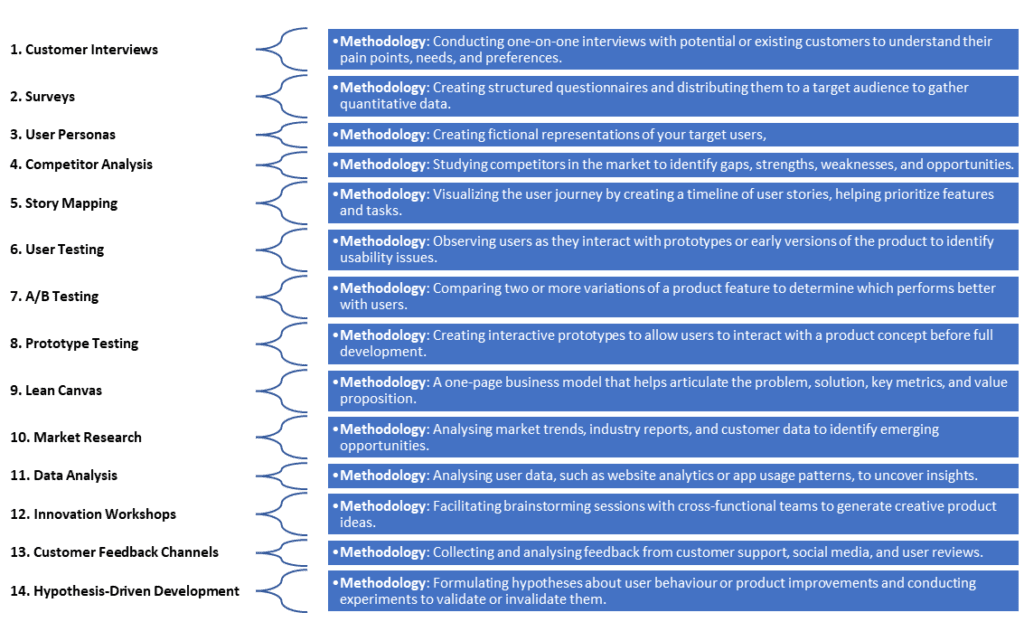Product Discovery Methods : In the ever-evolving landscape of product development, success hinges on the ability to understand customer needs, identify market opportunities, and build products that resonate with users. This crucial phase is known as “product discovery.” It’s a multifaceted journey that involves research, ideation, validation, and prioritization. In this comprehensive guide, we will delve into the intricacies of various product discovery methods, shedding light on their unique aspects and providing real-world examples.


Product Discovery Methods
Table of Contents
Introduction to Product Discovery Methods
Product Discovery Methods:: Product discovery is the initial phase of the product development process, where the focus is on understanding customer problems, exploring potential solutions, and validating assumptions. It’s a critical step that can save time, resources, and effort in the long run by ensuring that you’re building the right product for the right audience.
The Importance of Product Discovery
Effective product discovery has several key advantages:
- Risk Mitigation: It helps identify potential risks and challenges early in the development process, reducing the likelihood of costly mistakes later on.
- Customer-Centric Approach: By putting the customer at the centre of the process, product discovery ensures that the resulting product aligns with user needs and preferences.
- Innovation: It fosters innovation by encouraging teams to explore new ideas and solutions.
- Efficiency: A well-executed product discovery phase streamlines the product development process, resulting in faster time-to-market.
Now, let’s explore various product discovery methods in detail, each with its own unique characteristics and real-world examples.


Product Discovery Methods
1. Customer Interviews
Methodology: Conducting one-on-one interviews with potential or existing customers to understand their pain points, needs, and preferences.
Unique Aspect: Customer interviews provide direct and qualitative insights into user behaviour and motivations.
Example: In the context of a ride-sharing app, interviews may reveal that customer value safety features more than discounted fares. This insight could lead to the prioritization of safety enhancements.
2. Surveys
Methodology: Creating structured questionnaires and distributing them to a target audience to gather quantitative data.
Unique Aspect: Surveys allow you to collect data from a larger sample size efficiently.
Example: A software company may use surveys to assess user satisfaction and identify areas for improvement. A high volume of survey responses indicating dissatisfaction with a particular feature could trigger further investigation.
3. User Personas
Methodology: Creating fictional representations of your target users, complete with demographic details, behaviours, and goals.
Unique Aspect: User personas help product teams empathize with and design for their ideal customers.
Example: For an e-commerce platform, user personas might include “Sarah,” a busy working mother looking for quick and convenient shopping options, and “David,” a tech-savvy college student seeking unique and affordable products.
4. Competitor Analysis
Methodology: Studying competitors in the market to identify gaps, strengths, weaknesses, and opportunities.
Unique Aspect: Competitor analysis provides insights into what works and what doesn’t in the industry.
Example: An email marketing software company may analyse competitors’ pricing strategies, feature sets, and customer reviews to identify areas where they can differentiate themselves.
5. Story Mapping
Methodology: Visualizing the user journey by creating a timeline of user stories, helping prioritize features and tasks.
Unique Aspect: Story mapping fosters collaboration among cross-functional teams and aligns everyone on the product’s vision.
Example: When developing a project management tool, story mapping can reveal that user onboarding is a critical first step, followed by task creation and team collaboration features.
6. User Testing
Methodology: Observing users as they interact with prototypes or early versions of the product to identify usability issues.
Unique Aspect: User testing provides actionable insights into how users navigate and experience the product.
Example: A mobile app development team may discover through user testing that users frequently struggle with the login process, leading to a redesign of the authentication flow for improved user experience.
7. A/B Testing
Methodology: Comparing two or more variations of a product feature to determine which performs better with users.
Unique Aspect: A/B testing provides data-driven evidence for decision-making.
Example: An e-commerce website might run an A/B test to compare two different checkout page designs. The one with a higher conversion rate becomes the default.
8. Prototype Testing
Methodology: Creating interactive prototypes to allow users to interact with a product concept before full development.
Unique Aspect: Prototype testing helps validate assumptions and gather feedback before investing in extensive development.
Example: Before building a new mobile game, the development team creates a prototype to test the core gameplay mechanics and receive user feedback on the fun factor and playability.
9. Lean Canvas
Methodology: A one-page business model that helps articulate the problem, solution, key metrics, and value proposition.
Unique Aspect: Lean Canvas provides a concise framework for early-stage startups to outline their business idea.
Example: A social networking startup may use the Lean Canvas to map out how they plan to solve a specific social interaction problem and attract users through their unique features.
10. Market Research
Methodology: Analysing market trends, industry reports, and customer data to identify emerging opportunities.
Unique Aspect: Market research informs product development by revealing broader market dynamics.
Example: An IoT device manufacturer may conduct market research to identify the growing demand for smart home solutions, leading to the development of a new product line.
11. Data Analysis
Methodology: Analysing user data, such as website analytics or app usage patterns, to uncover insights.
Unique Aspect: Data analysis relies on quantitative data to guide product decisions.
Example: A content platform might analyse user engagement metrics to discover that long-form articles perform better than short-form content, leading to a shift in content strategy.
12. Innovation Workshops
Methodology: Facilitating brainstorming sessions with cross-functional teams to generate creative product ideas.
Unique Aspect: Innovation workshops encourage diverse thinking and ideation.
Example: A technology company might host an innovation workshop to explore potential applications of emerging technologies like artificial intelligence and blockchain.
13. Customer Feedback Channels
Methodology: Collecting and analysing feedback from customer support, social media, and user reviews.
Unique Aspect: Customer feedback channels provide real-time insights into user sentiments and pain points.
Example: An e-commerce platform might discover recurring complaints about slow shipping times through monitoring customer feedback channels, prompting them to optimize their logistics.
14. Hypothesis-Driven Development
Methodology: Formulating hypotheses about user behaviour or product improvements and conducting experiments to validate or invalidate them.
Unique Aspect: Hypothesis-driven development fosters a culture of continuous improvement and learning.
Example: A software-as-a-service (SaaS) company might hypothesize that adding a mobile app will increase user retention. They can then experiment by releasing a mobile app and measuring its impact.
Product Discovery Methods : Conclusion
Product Discovery Methods: In the dynamic realm of product discovery, no one-size-fits-all approach exists. The effectiveness of a method depends on the context, goals, and constraints of your project. By incorporating a mix of these product discovery methods, you can increase your chances of building a successful product that truly resonates with your target audience. Always remember that

